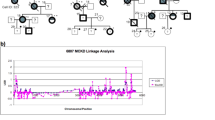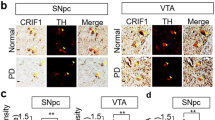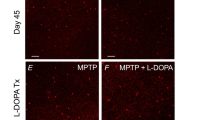Abstract
There is no established genetic model of bipolar disorder or major depression, which hampers research of these mood disorders. Although mood disorders are multifactorial diseases, they are sometimes manifested by one of pleiotropic effects of a single major gene defect. We focused on chronic progressive external ophthalmoplegia (CPEO), patients with which sometimes have comorbid mood disorders. Chronic progressive external ophthalmoplegia is a mitochondrial disease, which is accompanied by accumulation of mitochondrial DNA (mtDNA) deletions caused by mutations in nuclear-encoded genes such as POLG (mtDNA polymerase). We generated transgenic mice, in which mutant POLG was expressed in a neuron-specific manner. The mice showed forebrain-specific defects of mtDNA and had altered monoaminergic functions in the brain. The mutant mice exhibited characteristic behavioral phenotypes, a distorted day–night rhythm and a robust periodic activity pattern associated with estrous cycle. These abnormal behaviors resembling mood disorder were worsened by tricyclic antidepressant treatment and improved by lithium, a mood stabilizer. We also observed antidepressant-induced mania-like behavior and long-lasting irregularity of activity in some mutant animals. Our data suggest that accumulation of mtDNA defects in brain caused mood disorder-like mental symptoms with similar treatment responses to bipolar disorder. These findings are compatible with mitochondrial dysfunction hypothesis of bipolar disorder.
This is a preview of subscription content, access via your institution
Access options
Subscribe to this journal
Receive 12 print issues and online access
$259.00 per year
only $21.58 per issue
Buy this article
- Purchase on Springer Link
- Instant access to full article PDF
Prices may be subject to local taxes which are calculated during checkout






Similar content being viewed by others
References
American Psychiatric Association. Diagnostic and Statistical Manual of Mental Disorders, Fourth Edition. Text Revision (DSM-IV-TR), 2000.
Merikangas KR, Low NC . The epidemiology of mood disorders. Curr Psychiatry Rep 2004; 6: 411–421.
Goodwin FK, Jamison KR . Manic-Depressive Illness. Oxford University Press: New York, 1990.
Kato T, Kato N . Mitochondrial dysfunction in bipolar disorder. Bipolar Disord 2000; 2: 180–190.
Kato T, Takahashi S, Shioiri T, Inubushi T . Alterations in brain phosphorous metabolism in bipolar disorder detected by in vivo31P and 7Li magnetic resonance spectroscopy. J Affect Disord 1993; 27: 53–59.
Kato T, Kunugi H, Nanko S, Kato N . Mitochondrial DNA polymorphisms in bipolar disorder. J Affect Disord 2001; 62: 151–164.
Munakata K, Tanaka M, Mori K, Washizuka S, Yoneda M, Tajima O et al. Mitochondrial DNA 3644T → C mutation associated with bipolar disorder. Genomics 2004; 84: 1041–1050.
Munakata K, Iwamoto K, Bundo M, Kato T . Mitochondrial DNA 3243A>G mutation and increased expression of LARS2 gene in the brains of patients with bipolar disorder and schizophrenia. Biol Psychiatry 2005; 57: 525–532.
Washizuka S, Iwamoto K, Kazuno A, Kakiuchi C, Mori K, Kametani M et al. Association of mitochondrial complex I subunit gene NDUFV2 at 18p11 with bipolar disorder in Japanese and the NIMH pedigrees. Biol Psychiatry 2004; 56: 483–489.
Konradi C, Eaton M, MacDonald ML, Walsh J, Benes FM, Heckers S et al. Molecular evidence for mitochondrial dysfunction in bipolar disorder. Arch Gen Psychiatry 2004; 61: 300–308.
Iwamoto K, Bundo M, Kato T . Altered expression of mitochondria-related genes in postmortem brains of patients with bipolar disorder or schizophrenia, as revealed by large-scale DNA microarray analysis. Hum Mol Genet 2005; 14: 241–253.
Krishnan KR . Psychiatric and medical comorbidities of bipolar disorder. Psychosom Med 2005; 67: 1–8.
Siciliano G, Tessa A, Petrini S, Mancuso M, Bruno C, Grieco GS et al. Autosomal dominant external ophthalmoplegia and bipolar affective disorder associated with a mutation in the ANT1 gene. Neuromuscul Disord 2003; 13: 162–165.
Deschauer M, Hudson G, Muller T, Taylor RW, Chinnery PF, Zierz S et al. A novel ANT1 gene mutation with probable germline mosaicism in autosomal dominant progressive external ophthalmoplegia. Neuromuscul Disord 2005; 15: 311–315.
Spelbrink JN, Li FY, Tiranti V, Nikali K, Yuan Q-P, Tariq M et al. Human mitochondrial DNA deletions associated with mutations in the gene encoding Twinkle, a phage T7 gene 4-like protein localized in mitochondria. Nat Genet 2001; 28: 223–231.
Van Goethem G, Dermaut B, Löfgren A, Martin JJ, Van Broeckhoven C . Mutation of POLG is associated with progressive external ophthalmoplegia characterized by mtDNA deletions. Nat Genet 2001; 28: 211–212.
Mancuso M, Filosto M, Bellan M, Liguori R, Montagna P, Baruzzi A et al. POLG mutations causing ophthalmoplegia, sensorimotor polyneuropathy, ataxia, and deafness. Neurology 2004; 62: 316–318.
Luoma P, Melberg A, Rinne JO, Kaukonen JA, Nupponen NN, Chalmers RM et al. Parkinsonism, premature menopause, and mitochondrial DNA polymerase γ mutations: clinical and molecular genetic study. Lancet 2004; 364: 875–882.
Van Goethem G, Löfgren A, Dermaut B, Ceuterick C, Martin J-J, Van Broeckhoven C et al. Digenic progressive external ophthalmoplegia in a sporadic patient: Recessive mutations in POLG and C10orf2/Twinkle. Hum Mutat 2003; 22: 175–176.
Suomalainen A, Majander A, Haltia M, Somer H, Lonnqvist J, Savontaus ML et al. Multiple deletions of mitochondrial DNA in several tissues of a patient with severe retarded depression and familial progressive external ophthalmoplegia. J Clin Invest 1992; 90: 61–66.
Van Goethem G, Luoma P, Rantamaki M, Al Memar A, Kaakkola S, Hackman P et al. POLG mutations in neurodegenerative disorders with ataxia but no muscle involvement. Neurology 2004; 63: 1251–1257.
Kato T, Stine OC, McMahon FJ, Crowe RR . Increased levels of a mitochondrial DNA deletion in the brain of patients with bipolar disorder. Biol Psychiatry 1997; 42: 871–875.
Kato T, Takahashi S, Shioiri T, Murashita J, Hamakawa H, Inubushi T et al. Reduction of brain phosphocreatine in bipolar II disorder detected by phosphorus-31 magnetic resonance spectroscopy. J Affect Disord 1994; 31: 125–133.
Murashita J, Kato T, Shioiri T, Inubushi T, Kato N . Altered brain energy metabolism in lithium-resistant bipolar disorder detected by photic stimulated 31P-MR spectroscopy. Psychol Med 2000; 30: 107–115.
Barbiroli B, Montagna P, Martinelli P, Lodi R, Iotti S, Cortelli P et al. Defective brain energy metabolism shown by in vivo31P MR spectroscopy in 28 patients with mitochondrial cytopathies. J Cereb Blood Flow Metab 1993; 13: 469–474.
Rango M, Bozzali M, Prelle A, Scarlato G, Bresolin N . Brain activation in normal subjects and in patients affected by mitochondrial disease without clinical central nervous system involvement: a phosphorus magnetic resonance spectroscopy study. J Cereb Blood Flow Metab 2001; 21: 85–91.
Dager SR, Friedman SD, Parow A, Demopulos C, Stoll AL, Lyoo IK et al. Brain metabolic alterations in medication-free patients with bipolar disorder. Arch Gen Psychiatry 2004; 61: 450–458.
Stork C, Renshaw PF . Mitochondrial dysfunction in bipolar disorder: evidence from magnetic resonance spectroscopy research. Mol Psychiatry 2005; 10: 900–919.
Zhang D, Mott JL, Chang SW, Denniger G, Feng Z, Zassenhaus HP et al. Construction of transgenic mice with tissue-specific acceleration of mitochondrial DNA mutagenesis. Genomics 2000; 69: 151–161.
Trifunovic A, Wredenberg A, Falkenberg M, Spelbrink JN, Rovio AT, Bruder CE et al. Premature ageing in mice expressing defective mitochondrial DNA polymerase. Nature 2004; 429: 417–423.
Kujoth GC, Hiona A, Pugh TD, Someya S, Panzer K, Wohlgemuth SE et al. Mitochondrial DNA mutations, oxidative stress, and apoptosis in mammalian aging. Science 2005; 309: 481–484.
Mayford M, Baranes D, Podsypanina K, Kandel ER . The 3′-untranslated region of CaMKIIα is a cis-acting signal for the localization and translation of mRNA in dendrites. Proc Natl Acad Sci USA 1996; 93: 13250–13255.
World Health Organization. ICD 10: International Statistical Classification of Diseases and Related Health Problems (10 version). Geneva, Switzerland, 1992.
Einat H, Manji HK, Belmaker RH . New approaches to modeling bipolar disorder. Psychopharmacol Bull 2003; 37: 47–63.
Machado-Vieira R, Kapczinski F, Soares JC . Perspectives for the development of animal models of bipolar disorder. Prog Neuropsychopharmacol Biol Psychiatry 2004; 28: 209–224.
Miyamoto Y, Yamada K, Noda Y, Mori H, Mishina M, Nabeshima T et al. Lower sensitivity to stress and altered monoaminergic neuronal function in mice lacking the NMDA receptor ɛ4 subunit. J Neurosci 2002; 22: 2335–2342.
Ruf T . The Lomb-Scargle periodogram in biological rhythm: analysis of incomplete and unequally spaced time-series. Biol Rhythm Res 1999; 30: 178–201.
Goldberg JF, Truman CJ . Antidepressant-induced mania: an overview of current controversies. Bipolar Disord 2003; 5: 407–420.
Storlien LH, Higson FM, Gleeson RM, Smythe GA, Atrens DM . Effects of chronic lithium, amitriptyline and mianserin on glucoregulation, corticosterone and energy balance in the rat. Pharmacol Biochem Behav 1985; 22: 119–125.
Nelson JF, Felicio LS, Randall PK, Sims C, Finch CE . A longitudinal study of estrous cyclicity in aging C57BL/6J mice: I Cycle frequency, length and vaginal cytology. Biol Reprod 1982; 27: 327–339.
Carney SM, Goodwin GM . Lithium – a continuing story in the treatment of bipolar disorder. Acta Psychiatr Scand 2005; 111 (Suppl 426): 7–12.
Bschor T, Lewitzka U, Sasse J, Adli M, Koberle U, Bauer M et al. Lithium augmentation in treatment-resistant depression: clinical evidence, serotonergic and endocrine mechanisms. Pharmacopsychiatry 2003; 36 (Suppl 3): S230–S234.
Belke TW . Running and responding reinforced by the opportunity to run: effect of reinforcer duration. J Exp Anal Behav 1997; 67: 337–351.
Sherwin CM . Voluntary wheel running: a review and novel interpretation. Anim Behav 1998; 56: 11–27.
Daimon K, Yamada N, Tsujimoto T, Takahashi S . Circadian rhythm abnormalities of deep body temperature in depressive disorders. J Affect Disord 1992; 26: 191–198.
Hirschfeld RM . History and evolution of the monoamine hypothesis of depression. J Clin Psychiatry 2000; 61 (Suppl 6): 4–6.
Charney DS . Monoamine dysfunction and the pathophysiology and treatment of depression. J Clin Psychiatry 1998; 59 (Suppl 14): 11–14.
Young LT, Warsh JJ, Kish SJ, Shannak K, Hornykeiwicz O . Reduced brain 5-HT and elevated NE turnover and metabolites in bipolar affective disorder. Biol Psychiatry 1994; 35: 121–127.
Sobczak S, Honig A, van Duinen MA, Riedel WJ . Serotonergic dysregulation in bipolar disorders: a literature review of serotonergic challenge studies. Bipolar Disord 2002; 4: 347–356.
Blehar MC, DePaulo Jr JR, Gershon ES, Reich T, Simpson SG, Nurnberger Jr JI et al. Women with bipolar disorder: findings from the NIMH Genetics Initiative sample. Psychopharmacol Bull 1998; 34: 239–243.
Rasgon N, Bauer M, Grof P, Gyulai L, Elman S, Glenn T et al. Sex-specific self-reported mood changes by patients with bipolar disorder. J Psychiatr Res 2005; 39: 77–83.
Steiner M, Haskett RF, Osmun JN, Carroll BJ . Treatment of premenstrual tension with lithium carbonate. A pilot study. Acta Psychiatr Scand 1980; 61: 96–102.
Karadag F, Akdeniz F, Erten E, Pirildar S, Yucel B, Polat A et al. Menstrually related symptom changes in women with treatment-responsive bipolar disorder. Bipolar Disord 2004; 6: 253–259.
Perry W, Minassian A, Feifel D, Braff DL . Sensorimotor gating deficits in bipolar disorder patients with acute psychotic mania. Biol Psychiatry 2001; 50: 418–424.
Rich BA, Vinton D, Grillon C, Bhangoo RK, Leibenluft E . An investigation of prepulse inhibition in pediatric bipolar disorder. Bipolar Disord 2005; 7: 198–203.
Barrett SL, Kelly C, Watson DR, Bell R, King DJ . Normal levels of prepulse inhibition in the euthymic phase of bipolar disorder. Psychol Med 2005; 35: 1737–1746.
Ludewig S, Geyer MA, Ramseier M, Vollenweider FX, Rechsteiner E, Cattapan-Ludewig K et al. Information-processing deficits and cognitive dysfunction in panic disorder. J Psychiatry Neurosci 2005; 30: 37–43.
Simon NM, Otto MW, Wisniewski SR, Fossey M, Sagduyu K, Frank E et al. Anxiety disorder comorbidity in bipolar disorder patients: data from the first 500 participants in the Systematic Treatment Enhancement Program for Bipolar Disorder (STEP-BD). Am J Psychiatry 2004; 161: 2222–2229.
Graziewicz MA, Longley MJ, Bienstock RJ, Zeviani M, Copeland WC . Structure-function defects of human mitochondrial DNA polymerase in autosomal dominant progressive external ophthalmoplegia. Nat Struct Mol Biol 2004; 11: 770–776.
Spelbrink JN, Toivonen JM, Hakkaart GA, Kurkela JM, Cooper HM, Lehtinen SK et al. In vivo functional analysis of the human mitochondrial DNA polymerase POLG expressed in cultured human cells. J Biol Chem 2000; 275: 24818–24828.
Luoma P, Melberg A, Rinne JO, Kaukonen JA, Nupponen NN, Chalmers RM et al. Parkinsonism, premature menopause, and mitochondrial DNA polymerase γ mutations: clinical and molecular genetic study. Lancet 2004; 364: 875–882.
Van Goethem G, Luoma P, Rantamaki M, Al Memar A, Kaakkola S, Hackman P et al. POLG mutations in neurodegenerative disorders with ataxia but no muscle involvement. Neurology 2004; 63: 1251–1257.
Hakonen AH, Heiskanen S, Juvonen V, Lappalainen I, Luoma PT, Rantamaki M et al. Mitochondrial DNA polymerase W748S mutation: a common cause of autosomal recessive ataxia with ancient European origin. Am J Hum Genet 2005; 77: 430–441.
Di Fonzo A, Bordoni A, Crimi M, Sara G, Del Bo R, Bresolin N et al. POLG mutations in sporadic mitochondrial disorders with multiple mtDNA deletions. Hum Mutat 2003; 22: 498–499.
Pozzan T, Magalhaes P, Rizzuto R . The comeback of mitochondria to calcium signalling. Cell Calcium 2000; 28: 279–283.
Soares JC, Mallinger AG . Intracellular phosphatidylinositol pathway abnormalities in bipolar disorder patients. Psychopharmacol Bull 1997; 33: 685–691.
Yamawaki S, Kagaya A, Okamoto Y, Shimizu M, Nishida A, Uchitoni Y . Enhanced calcium response to serotonin in platelets from patients with affective disorders. J Psychiatry Neurosci 1996; 21: 321–324.
Hahn C-G, Gomez G, Restrepo D, Friedman E, Josiassen R, Pribitkin EA et al. Aberrant intracellular calcium signaling in olfactory neurons from patients with bipolar disorder. Am J Psychiatry 2005; 162: 616–618.
Kasamatsu H, Robberson DL, Vinograd J . A novel closed-circular mitochondrial DNA with properties of a replicating intermediate. Proc Natl Acad Sci USA 1971; 68: 2252–2257.
Acknowledgements
We thank Dr Mark Mayford (The Scripps Research Institute) for the CaMKIIα promoter constructs (pNN265 and pMM403). We are grateful to staffs in Divisions of Animal Experiments and Common Instrumentations (Research Resources Center, Brain Science Institute [BSI], RIKEN) for technical assistance and members in our laboratory for useful discussions. This work was supported by the Grants for Laboratory for Molecular Dynamics of Mental Disorders, RIKEN BSI, Grant-in-Aid from the Japanese Ministry of Health and Labor, and Grants-in-Aid from the Japanese Ministry of Education, Culture, Sports, Science and Technology. T Kasahara is supported by a special postdoctoral researcher fellowship (RIKEN).
Author information
Authors and Affiliations
Corresponding author
Additional information
Accession Numbers and Electronic-Database Information
The DDBJ/EMBL/GenBank accession numbers of the sequences discussed in this paper are the following: mouse POLG cDNA, AB121698; and C57BL/6J mouse mtDNA AY172335.
The Mendelian Inheritance in Man (http://www.ncbi.nlm.nih.gov/omim/) entry numbers of CPEO are 157640 (caused by mutation in the POLG gene), 609283 (caused by mutation in the ANT1 gene), and 609286 (caused by mutation in the Twinkle gene).
Supplementary Information accompanies the paper on the Molecular Psychiatry website (http://www.nature.com/mp)
Supplementary information
Rights and permissions
About this article
Cite this article
Kasahara, T., Kubota, M., Miyauchi, T. et al. Mice with neuron-specific accumulation of mitochondrial DNA mutations show mood disorder-like phenotypes. Mol Psychiatry 11, 577–593 (2006). https://doi.org/10.1038/sj.mp.4001824
Received:
Revised:
Accepted:
Published:
Issue Date:
DOI: https://doi.org/10.1038/sj.mp.4001824
Keywords
This article is cited by
-
Brain mitochondrial diversity and network organization predict anxiety-like behavior in male mice
Nature Communications (2023)
-
GWAS-identified bipolar disorder risk allele in the FADS1/2 gene region links mood episodes and unsaturated fatty acid metabolism in mutant mice
Molecular Psychiatry (2023)
-
Cell-type-specific DNA methylation analysis of the frontal cortices of mutant Polg1 transgenic mice with neuronal accumulation of deleted mitochondrial DNA
Molecular Brain (2022)
-
Enlightened: addressing circadian and seasonal changes in photoperiod in animal models of bipolar disorder
Translational Psychiatry (2021)
-
Blood-based mitochondrial respiratory chain function in major depression
Translational Psychiatry (2021)



